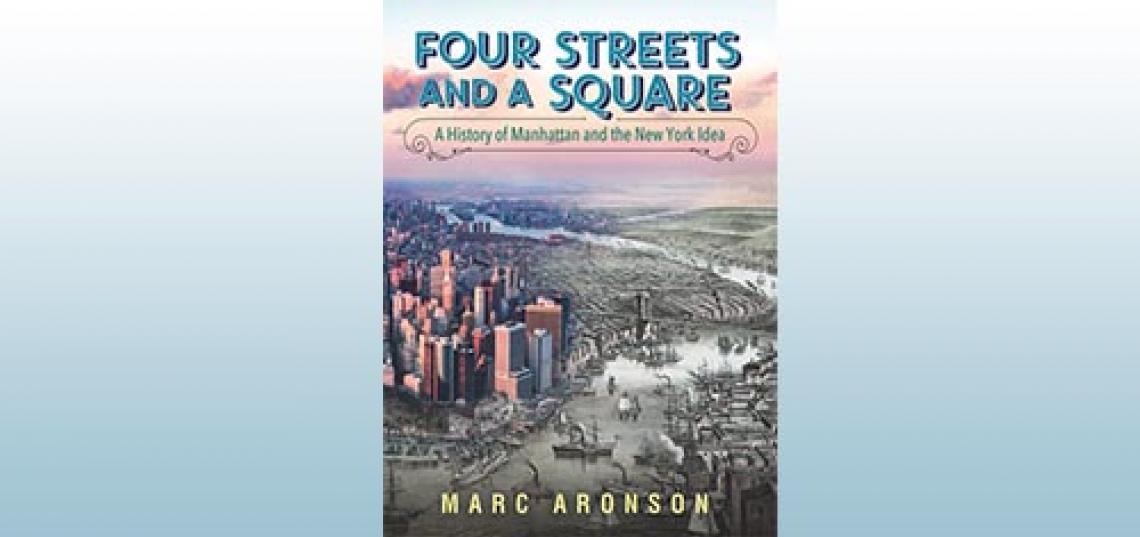
What can an exploration of only four streets in Manhattan (Wall Street, 42nd Street, West 4th Street, and 125th Street), and one square (Union Square) tell us about 400 years of the island’s history, which is undeniably vibrant and fascinating?
In Associate Professor of Practice Marc Aronson’s newest book, “Four Streets and a Square: A History of Manhattan and the New York Idea,” Aronson takes readers on an exciting journey into the past to understand how Manhattan, one of the most dynamic and legendary boroughs in one of the most famous cities in the world, developed. In the book Aronson also explores what he has coined the ‘New York Idea’ – which is “the value of mixture, of people, of ideas, of cultures found in New York City.”
“The most surprising knowledge I gained was of the direct connections between the gender explorations of same-sex attraction and desire in the city, especially Greenwich Village, and the Harlem Renaissance,” Aronson said.
Aronson begins his history on Wall Street, during the years 1600-1800, when the borough began life as a Dutch settlement named New Amsterdam. In this section readers journey through the city’s transition to a British colony, and then through the American Revolution.
The next stop is Union Square, where Aronson chronicles the borough’s growth during 1800-1890, when Manhattan became a place of refuge for millions of people from all over the world. A focus on Forty-Second street showcases the borough’s development between 1900 and 1920. This section also includes the history of 125th Street and West Fourth Street from 1910 – 1930s, during World War One, and the history of Harlem.
In the chapter “The City Suffers,” Aronson returns to all four streets and Union Square to explore what happened in Manhattan during the Great Depression (which began in 1929) and World War Two, during the years 1930-1945. The final chapter covers 1945-present.
The book includes over 200 images and 15 maps which Aronson said were created specifically for the book to “make the academic ideas more accessible to a wide audience.”
Aronson said he also designed the book to provide an immersive experience -- to ensure readers can hear, see, and feel Manhattan’s energy through time. At the beginning of the book he invites readers to go to marcaronson.com and then as they read, to click on the additional resources which he has indicated throughout the book in the margins by using three icons, a building, which references links to historical sites; a book, which links to complete texts of other books and sources; and a computer, which takes readers to sites where they can hear the sounds of the streets and music, and see its art on the streets and in the museums; and visit other sites that bring the history of the borough to life.
He became inspired to delve deeply into Manhattan’s history for several reasons, Aronson said. One inspiration came from his experiences growing up in Manhattan. Another inspiration came from “reading about vaudeville in the 19th century -- which made fun of many ethnic groups, but also employed immigrants and native-born Americans and spoke to mixed audiences. I was interested in that mix of satirizing people, stereotyping, but also sharing, elevating, making stars and stories out of the many different lives on the city's streets.”
After spending six years researching and writing the book, Aronson said he was still surprised by some of his findings. “The most surprising knowledge I gained was of the direct connections between the gender explorations of same-sex attraction and desire in the city, especially Greenwich Village, and the Harlem Renaissance,” Aronson said.
Aronson said he was also inspired by “Dr. Jeffrey Stewart’s brilliant and award-winning biography of Alain Locke,” which was published while Aronson was working on “Four Streets.” He said reading Stewart’s book “helped me ground my research in this area.”
The book includes over 200 images and 15 maps which Aronson said were created specifically for the book to “make the academic ideas more accessible to a wide audience.”
The book's publisher, Candlewick says, on the Penguin Random House site, “. . . Marc Aronson explores how new ideas and forms of art evolved from social blending. Centuries of conflict—among original Americans and Europeans, slavers and the enslaved, rich and poor, immigrants and native-born—produced segregation, oppression, and violence, but also new ways of speaking, singing, and being American. From the Harlem Renaissance to Hammerstein, from gay pride in the Village to political clashes at Tammany Hall, this clear-eyed pageant of the island’s joys and struggles—enhanced with photos and drawings, multimedia links to music and film, and an extensive bibliography and source notes—is, above all, a love song to Manhattan’s triumphs.”
Robert W. Snyder, Manhattan Borough Historian and professor emeritus at Rutgers University–Newark, wrote in a book review, “In this insightful book, Marc Aronson invites a new generation of readers to explore the island where New York City was born. Imaginatively conceived, vividly written, and creatively illustrated, ‘Four Streets and a Square’ is a rewarding read.”
In another book review, Tyler Anbinder, professor of history at George Washington University and author of “City of Dreams: The 400-Year Epic History of Immigrant New York,” wrote, “Anyone who loves New York will love ‘Four Streets and a Square.’ It is gorgeously illustrated and chock full of fascinating facts about every period of the city’s history.”
"Four Streets and a Square" is currently available in hardcover, audio, or e-book.
Discover more about the Department of Library and Information Science at the Rutgers School of Communication and Information on the website.
Book cover image courtesy of Marc Aronson
